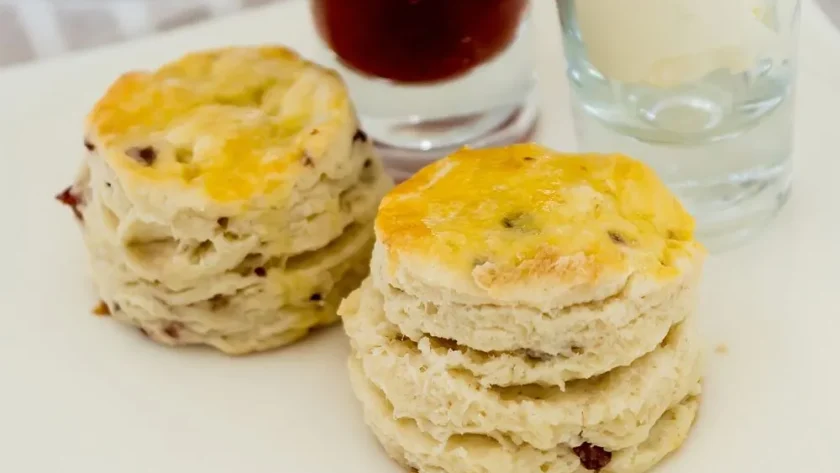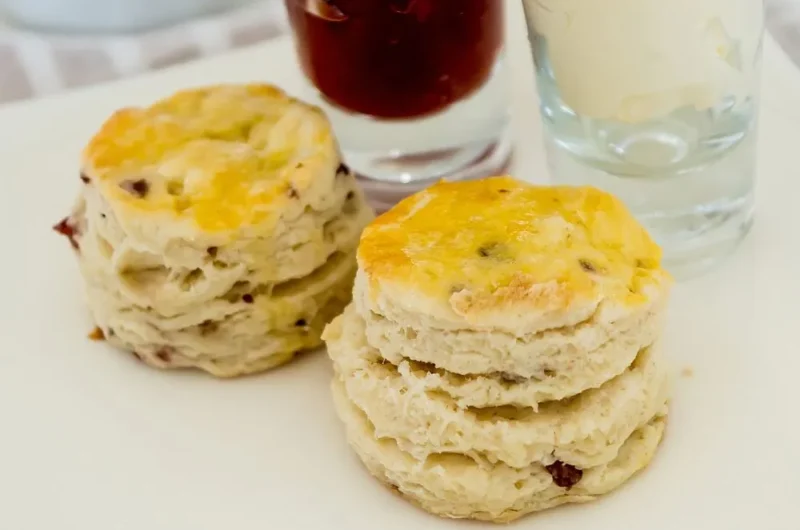I first tried making these on a damp Tuesday afternoon when my fridge was bare but for a sad tub of buttermilk and one egg rolling about like it had big plans. I wasn’t expecting much—just needed a quick bake to lift the mood. But let me tell you, these buttermilk scones were magic.
That said, I nearly ruined them the first go. Thought I’d be clever and use my mixer—bad idea. The dough went tough, and the rise? Non-existent. I had more lift from my morning slippers.
Once I learned to barely touch the dough and leave it a bit sticky, everything changed. Now they come out soft as clouds with that subtle buttermilk tang I can’t get enough of.
Let me show you exactly how I fixed it—and how to make these beauties sing.
WHY THIS ONE WORKS SO WELL
There’s a reason these scones don’t need bells and whistles—just a light hand and a cold bowl.
- Buttermilk gives them that gentle tang and tender crumb. It reacts with the baking soda for a better rise too.
- Softened butter (not melted!) rubs in like a dream. I’ve tried chilled cubes, but they didn’t blend as evenly.
- No fancy resting time, but covering the warm scones with a tea towel post-bake keeps them extra pillowy.
Most scone recipes fall flat because folks overmix or overknead. This one begs you to be lazy with the dough—and I’m here for that energy.
INGREDIENTS + WHY THEY MATTER
- All-purpose flour (375g) – Just the right strength. Bread flour was too chewy. Self-raising made them weirdly cakey.
- Baking powder + soda – The combo gives both speed and structure. The soda reacts with buttermilk for height.
- Salted butter (55g) – Adds flavour and moisture. I used unsalted once and had to pile on extra jam.
- Sugar (50g) – Balances the tang. Not too much, just enough.
- Buttermilk (240ml) – The star. Makes them ultra-tender. Tried yogurt once—it worked, but the texture was denser.
- 1 extra-large egg – Adds richness and colour. Reserve a bit for that golden glaze.
- Extra milk or buttermilk – For brushing. Makes them shine up beautifully.
MAKING IT YOURS (WITHOUT RUINING IT)
- No egg? You can skip it and just use a bit more buttermilk. The tops won’t brown as much, but still tasty.
- Gluten-free – I tested with a GF plain flour blend. They didn’t rise quite as high but still soft. Add ¼ tsp xanthan gum.
- Dairy-free – Oat milk + 1 tsp lemon juice in place of buttermilk was surprisingly solid. Use plant-based butter too.
- Add-ins – ½ cup of chopped dried apricots or cranberries work a treat. Just toss in flour first so they don’t sink.
MISTAKES I’VE MADE (AND HOW TO AVOID THEM
| What Went Wrong | Why It Happens | How to Fix It |
|---|---|---|
| Scones turned out tough | Overmixed the dough | Stir just until it comes together |
| Barely rose | Warm butter or overworked dough | Use cool ingredients + handle gently |
| Dry and crumbly | Not enough liquid | Add a splash more buttermilk as needed |
| Burnt bottoms | Oven rack too low | Bake in top-middle of the oven |
HOW TO MAKE MARY BERRY’S BUTTERMILK SCONE
- Preheat your oven to 425°F (220°C). Line a tray with parchment or lightly grease.
- Mix dry ingredients: In a large bowl, whisk together flour, baking powder, baking soda, salt, and sugar.
- Rub in butter: Use your fingertips to work in the butter until it looks like fine breadcrumbs. Don’t rush this—should feel like damp sand.
- Add buttermilk + egg: Pour in the buttermilk and most of the beaten egg (save a bit for brushing). Stir gently—stop as soon as the dough holds together. A bit sticky is good.
- Shape: Lightly flour your counter. Turn out the dough, knead once or twice max, then pat or roll to about ¾ inch thick.
- Cut: Use a fluted 2-inch cutter, pressing straight down—no twisting. That helps with the rise.
- Bake: Place on your tray, brush tops with reserved egg or milk, and bake 12–15 minutes until golden and tall.
- Soften: Transfer to a wire rack and cover with a tea towel while warm. This keeps them tender.

TIPS FROM MY KITCHEN
- I use an old metal cutter. Plastic ones never give as clean a rise.
- If my buttermilk’s too cold, I warm it slightly—just enough to take the fridge chill off.
- I flour my cutter between each scone—stops sticking.
- My oven runs hot, so I start checking at 11 minutes.
STORAGE + SERVING
- Room Temp: Airtight tin for 2 days max. I pop mine back in a 350°F oven for 5 minutes to perk up.
- Freezer: Freeze once cooled in a sealed bag for up to 3 months. Reheat from frozen at 350°F for 10 mins.
- Serving: Best warm with strawberry jam and a proper blob of clotted cream. Or just butter, if you’re being honest.
FAQs – REAL QUESTIONS, REAL ANSWERS
Q: Can I use plain yogurt instead of buttermilk?
A: You can, but thin it with a little milk. The texture turns out slightly denser but still soft.
Q: Why didn’t my scones rise?
A: Likely the dough was overworked, or your leavening agents weren’t fresh. Also, check your oven’s running hot enough.
Q: Should I chill the dough before baking?
A: No need. These bake straight from shaping. Chilling made mine a bit dry.
Q: Can I make them smaller or bigger?
A: Yes, just adjust bake time. Mini scones need 8–10 mins, big ones 15–17.
Q: Is buttermilk better than milk for scones?
A: For this recipe? Absolutely. It gives lift, flavour, and softness that milk alone doesn’t.
Try More Recipes:
- Mary Berry Fruit Scones
- Mary Berry Very Best Scones
- Mary Berry Wholemeal Scones
- Mary Berry Cheese Scones
Mary Berry Buttermilk Scones Recipe
Course: AppetizersCuisine: UK12
Scones15
minutes15
minutes180
kcalSoft, tender scones with a tangy buttermilk twist—perfect warm with jam, butter, or clotted cream.
Ingredients
3 cups (375g) all-purpose flour, plus extra for dusting
1 tablespoon baking powder
½ teaspoon baking soda
½ teaspoon salt
¼ cup (55g) salted butter, softened
¼ cup (50g) sugar
1 cup (240ml) buttermilk
1 extra-large egg, beaten
A little milk or extra buttermilk, for brushing
Directions
- Preheat oven to 425°F (220°C). Line or grease baking tray.
- Mix flour, baking powder, soda, salt, and sugar.
- Rub in softened butter until mixture resembles fine breadcrumbs
- Add buttermilk and most of the egg. Mix gently to form a sticky dough.
- Lightly flour surface. Knead once or twice. Roll to ¾ inch thick.
- Cut scones with floured 2-inch cutter. Don’t twist.
- Place on tray, brush tops with egg or milk.
- Bake 12–15 mins until golden. Cool under tea towel.
Notes
- I use an old metal cutter. Plastic ones never give as clean a rise.
- If my buttermilk’s too cold, I warm it slightly—just enough to take the fridge chill off.
- I flour my cutter between each scone—stops sticking.
- My oven runs hot, so I start checking at 11 minutes.

